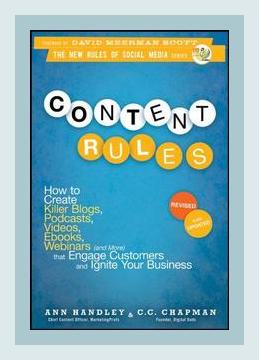Marketing and SalesSocial Media Marketing
Categories: Social Media Marketing
Introduction
In “Content Rules,” Ann Handley and C.C. Chapman provide a comprehensive guide on creating engaging content across various platforms to captivate an audience, build customer relationships, and drive business goals. The authors outline actionable steps and ethical guidelines for effective content creation.
1. Understanding Content Marketing
Major Point: Content marketing is about creating and sharing valuable free content to attract and convert prospects into customers, and customers into repeat buyers.
Action: Define your target audience and identify their needs and preferences.
2. The Value of Being Human
Major Point: Authenticity is key to resonating with your audience. Authentic, human-centered content builds trust and loyalty.
Action: Develop a brand voice that is personable and relatable.
Example: Southwest Airlines uses a casual and friendly tone that mirrors the brand’s fun and approachable personality.
3. Creating Solid Content Strategy
Major Point: A well-defined content strategy ensures a consistent and effective delivery of your message.
Action: Develop a content calendar to plan and schedule your content.
Example: American Express Open Forum publishes regular posts that offer practical advice to small business owners, adhering to a consistent posting schedule.
4. Defining Content Goals
Major Point: Clearly defined goals help measure the success of your content efforts.
Action: Set SMART goals (Specific, Measurable, Achievable, Relevant, Time-bound) for all content initiatives.
Example: A company might aim to increase blog traffic by 20% over the next six months by publishing high-quality, SEO-optimized posts.
5. Know Your Audience
Major Point: Understanding your audience’s demographics, behaviors, and preferences is crucial.
Action: Create buyer personas to better tailor your content.
Example: HubSpot utilizes detailed buyer personas to align its content with the specific needs of its marketing and sales audiences.
6. The Content Rules
Rule #1: Embrace Being a Publisher
Major Point: Companies need to think like publishers by focusing on delivering valuable content.
Action: Establish an editorial mission statement to guide your publishing strategy.
Example: Coca-Cola’s “Coca-Cola Journey” website blends brand storytelling with journalism, creating a publishing platform distinct from traditional marketing.
Rule #2: Insight Inspires Originality
Major Point: Unique, insightful content stands out and adds value.
Action: Leverage industry research and internal data to produce original insights.
Example: MarketingProfs uses data from its own research team to publish unique reports and insights on marketing trends.
Rule #3: Build Momentum
Major Point: Consistent content creation builds momentum and keeps your audience engaged.
Action: Regularly update your content based on audience feedback and behavior.
Example: Moz updates its blog frequently, accommodating the rapidly changing landscape of SEO by providing actionable insights and updates.
7. Content Creation Essentials
Storytelling
Major Point: People connect emotionally with stories more than they do with facts and figures.
Action: Incorporate storytelling techniques into your content.
Example: TOMS Shoes shares compelling stories about how each purchase improves lives, reinforcing its socially conscious brand ethic.
High-Quality Graphics and Visuals
Major Point: Visual content grabs attention and enhances message retention.
Action: Invest in high-quality images, infographics, and videos.
Example: Buffer uses well-designed graphics and visuals to explain complex social media strategies, making their blog visually appealing and informative.
Consistency is Key
Major Point: Consistency in voice, tone, and posting schedule builds trust.
Action: Develop a brand style guide to maintain consistency.
Example: MailChimp’s easy, friendly, and slightly quirky voice is maintained across all content, from blog posts to email updates.
8. Formats and Platforms
Blogs
Major Point: Blogs are foundational to content marketing, providing a platform for sharing detailed insights.
Action: Create a blog that addresses the pain points of your audience.
Example: Whole Foods’ blog offers recipes, wellness tips, and sustainability stories that resonate with their health-conscious audience.
Podcasts
Major Point: Podcasts allow for deep dives into topics and can engage users who prefer to listen rather than read.
Action: Launch a podcast series that complements your content strategy.
Example: The “HBR IdeaCast” by Harvard Business Review explores business leadership topics, reinforcing HBR’s authority in the business world.
Videos
Major Point: Videos are highly engaging and can be used for a variety of content types, from tutorials to testimonials.
Action: Create short, informative videos that provide value and entertain.
Example: Blendtec’s “Will It Blend?” series demonstrates the power of their blenders, blending everything from iPhones to marbles.
Ebooks and Whitepapers
Major Point: Ebooks and whitepapers can be used to provide in-depth information on a subject and capture leads.
Action: Offer free downloadable ebooks in exchange for users’ contact information.
Example: HubSpot offers numerous free ebooks on marketing strategies, which are used to capture leads and build their email list.
Webinars
Major Point: Webinars provide an interactive platform for in-depth content delivery and audience engagement.
Action: Host regular webinars on relevant industry topics.
Example: Salesforce offers webinars that showcase product features and industry trends, enhancing customer knowledge and engagement.
9. Distribution and Promotion
Major Point: Creating great content is only half the battle; the other half is getting it in front of the right people.
Action: Utilize social media, email marketing, and partnerships to distribute your content.
Example: GoPro leverages user-generated content and social media to showcase its products in action, encouraging sharing and increasing reach.
10. Measuring Success
Major Point: Analyzing the performance of your content helps refine your strategy and prove ROI.
Action: Use analytics tools to track key metrics such as engagement, traffic, and conversions.
Example: Google Analytics can help track blog traffic, user behavior, and the performance of specific posts to identify what works best.
Conclusion
“Content Rules” is a vital resource for anyone looking to enhance their content marketing efforts. Ann Handley and C.C. Chapman’s advice is grounded in real-world examples and actionable steps that businesses can implement immediately. By understanding the principles of great content creation, maintaining consistency, leveraging various formats, and effectively distributing and measuring content, organizations can significantly enhance their engagement and drive their business objectives.
